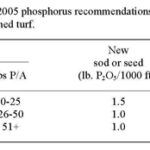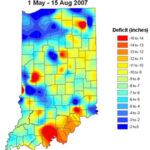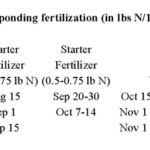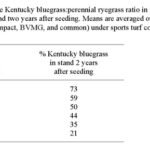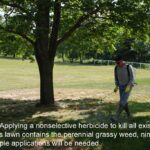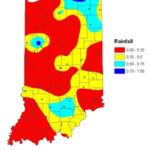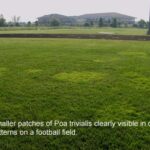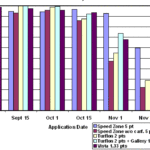Zac Reicher

Renovating Turf: How long should I wait to seed after a glyphosate (Roundup) application?
I have received a number of email questioning the wait for seeding after glyphosate applications. Glyphosate has no soil activity and will therefore not affect seedlings when seeded even the same day of application. However, for maximum control of tough-to-control weeds with stolons or rhizomes, a 7 day delay is recommended before raking or aerification […]
Fertilization: Do it right and protect the environment
Though much research over the years has shown that when fertilizer is applied properly to turf, it does not leach or runoff. The key to this is proper application as careless applications can cause problems. Following is a quick list of precautions when applying fertilizer (or pesticides) to your lawn. ·Apply the right rate and […]
September is Crucial for Fertilizing All Cool-Season Turfs
With the returning rains in the state, now is the most important time to fertilize cool-season turfgrasses like creeping bentgrass, Kentucky bluegrass, perennial ryegrass, and tall or fine fescue. September fertilization is crucial on all turf areas regardless if it is a lawn, athletic field, or golf course green, tee or fairway. Fertilization in mid-September […]
Precipitation Deficit Map as of 15 August
Though many parts of central IN was lucky enough to get significant rainfall this week, many parts of the state have not. Below is the Rainfall Deficit Map as of Aug 15, courtesy of the Indiana State Climate Office. This information and much weather information is available at www.iclimate.org
Rejuvenating Turf Areas After Drought
Eight weeks or more of high temperatures with minimal rain has taken a toll on turfgrasses around the state. Though some local areas in central IN have received ample rain in the last week, many areas are still very dry. We are just entering the window when significant turf recovery can be encouraged. Reseeding is […]
How much perennial ryegrass Kentucky bluegrass in a mix?
With the renovation season fast-approaching, questions abound about how much perennial ryegrass to use in a P. rye/K. bluegrass mix. Perennial ryegrass germinates quickly and provides quick cover and soil stabilization when used in a blend. However, too much perennial ryegrass leads to long-term problems from dollar spot, brown patch, red thread, and other diseases. […]
Turf Field Day Held July 17
Thank you to everyone who attended and helped make the 2007 Midwest Regional Turf Field Day a success on Tuesday, July 17. Though we had rain for the first time in at least 19 years that dramatically affected the day, this years registration easily topped 700. Attendees had the opportunity to view the latest in […]
Preemergence herbicides starting to break in hot spots
Crabgrass is starting to breakthrough in hotspots next to walks and drives, southern exposures, and in thin turf. Though many are quick to question the effectiveness of the specific preemergence herbicide used last spring, the vast majority of the breakthrough is due to weather, environment, or application techniques. Our research plots this year are showing […]
Nematode Survey Still On-Going
As summer stresses start to take a toll on our cool-season grasses on greens, more questions are arising about the potential of nematodes. We found ring and stunt nematodes in many of our samples from last year, but we’re not convinced yet that they are a primary cause in turf decline (see http://www.agry.purdue.edu/turf/tips/2006/nem112.htm for complete results). Pinpointing […]
Now is the Time to Start Improving Your Lawn
Tired of the way your lawn looks? If it hasn’t looked up to par this summer reseeding your lawn is an option. Mid-August is the best time to seed a new lawn or overseed an existing lawn, but planning should start now. If the lawn is just thin and needs a little help, fall is […]
White Clover in Golf Courses, Sports Turf, and Lawns
The small white flowers of white clover are very visible right now and it may appear that clover is taking over, especially under-fertilized turf areas. Clover is a legume and is very competitive under low N conditions, so increasing annual N is the best method for long-term control. The temptation is to apply a herbicide […]
Crabgrass and Yellow Nutsedge
Crabgrass and yellow nutsedge are really starting to flourish. Unfortunately, our options for control of either weed are becoming limited. Plus the hot temperatures increase the risk for turf damage with any herbicide applied now. The best current option for crabgrass is quinclorac (Drive or Quinclorac), which has the best activity among all the post […]
Midwest Regional Turf Field Day on July 17
There’s still time to register for the Midwest Regional Turf Field Day that will be held on Tuesday, July 17 at the W.H. Daniel Turfgrass Research and Diagnostic Center in West Lafayette . The variety and quality of research tours and other opportunities will make this one of the best field days yet. Topics include […]
Misery loves company: Yesterday’s state rainfall map
Though West Lafayette was lucky enough to get significant rainfall yesterday, not many other places in the state were as lucky. Below is a state rainfall map, courtesy of the Indiana State Climate Office. This information and much more weather information is available at www.iclimate.org
Lawn blemishes exposed by drought
Maintaining lawns and other turf areas is fairly straightforward in the cool and wet weather of the spring and fall, but things get tougher once the heat and drought set in. We are currently seeing a wide variety of problems, all of which are enhanced by the dry conditions. Problems that we are seeing include: […]
Don’t raise the mowing height during drought
Typical advice in the paper and TV is to raise the mowing height during drought to help the turf area stay green. However, this is very simplified advice which needs clarification. Here are some well-researched facts: • The higher you mow a grass plant, the deeper the roots. • Deeper roots mean a larger reservoir […]
Facts and Advice on Turf Survival in Drought
There are many questions about turf survival in drought with the on-going drought in most parts of the state. Though we understand many of the mechanisms turf survival in drought, it’s hard to duplicate all of the potential situations on research plots across the country and it’s difficult to give definite “black and white” recommendations […]
Midwest Regional Turf Field Day on July 17
Don’t forget to register for the Midwest Regional Turf Field Day that will be held on Tuesday, July 17 at the W.H. Daniel Turfgrass Research and Diagnostic Center in West Lafayette . This is a great opportunity for turf professionals to view the latest in turfgrass research, talk to Purdue specialists about turf and ornamental […]
Controlling Poa trivialis in sports fields
Poa trivialis is now common in sports fields, possibly due to as little as one contaminated seed source from the many overseedings done on sports fields. Once germinated, Poa trivialis spreads via stolons which may be further spread during every hollow tine aerification. Poa trivialis is shallow rooted, has poor wear resistance, is extremely susceptible to dollar spot, and often […]
Controlling ground ivy and/or violets
Ground ivy and violets are currently flowering and at their peak of beauty, but these two weeds remain tough to control in Indiana . Like almost all broadleaf weeds, flowering indicates a point in their lifecycle where they are susceptible to herbicide application. Even though applications now can produce visible damage, long-term control does not […]
